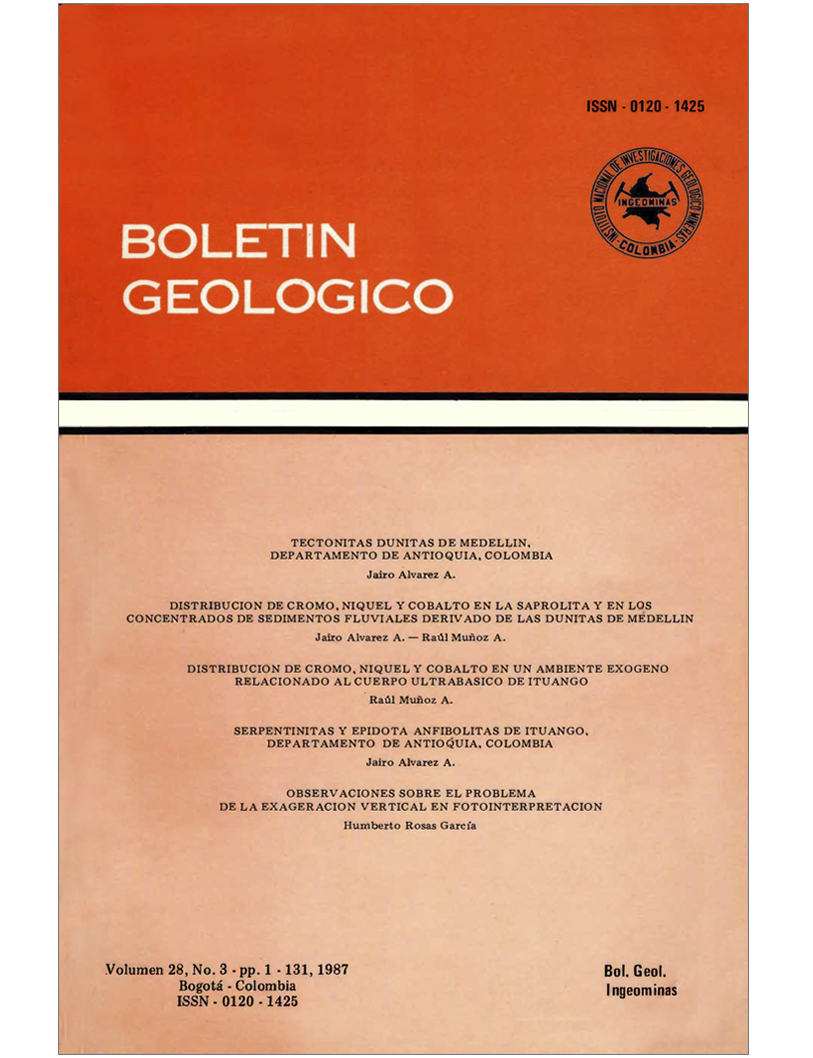Chromium, nickel, and cobalt distribution in saprolite and river sediment concentrates derived from Medellín dunites
DOI:
https://doi.org/10.32685/0120-1425/bolgeol28.3.1987.308Keywords:
Colombia, Santa Elena, Batea, podiform deposits, spectrography, geochemical prospectingLicense
Copyright (c) 1953 Servicio Geológico Colombiano

This work is licensed under a Creative Commons Attribution 4.0 International License.
Downloads
How to Cite
Issue
Section
Published
Abstract
In the Medellín dunite body, several podiform chromite deposits are present. In a restricted area of this body, around a chromite occurrence, a geochemical study was made on the distribution of Ni, Co, and Cr in the saprolite and the concentrates in the pan from the ultramafic e, to know the usefulness of these elements as indicators of mineralization. The analyses were carried out by semiquantitative spectrography.
In saprolite, nickel and cobalt are notoriously affected by chemical weathering being redistributed and leached and are not useful as occurrence indicators of chromite. Both elements have a higher geochemical coherence with iron than with manganese. On the other hand, chromium is found mainly in the resistor minerals (chromite and magnetite) and indicates the primary distribution of chromium in the dunite.
The zone to the west of the Patio Bonito deposit has high chromium values, suggesting a higher chromite concentration and better prospects for chromite bodies.
Geochemical prospecting using pan concentrates proved to be useful, and two anomalous areas were found in the catchment of the Las Palmas stream using this tool.
References
ÁLVAREZ, J., 1978. Exploración geoquímica. lnf. 1812. lngeominas, 27 p. Bogotá.
ÁLVAREZ, J., 1981. Aspectos petrológicos y geoquímicos de algunos cuerpos ultramáficos del sector septentrional de la Cordillera Central. (en preparación).
ÁLVAREZ, J., 1982. Tectonitas dunitas de Medellín, Departamento de Antioquia, Colombia. (Informe en preparación).
BOTERO, G., 1963. Contribución al conocimiento de la Geología de la zona central de Antioquia. An. Fac. de Minas, No. 57, 101 p. Medellín.
BOTERO, G., RICO, H., 1965.- Mapa Geológico de la Plancha 1-8 Medellín. Ministerio de Minas y Petróleos. Inventario Minero Nacional. Bogotá.
ESPINAL, L.S. 1964.- Formaciones vegetales del Departamento de Antioquia. Rev. Fac. Agron., V. 24, (60). 83 p. Medellín.
GOLDSCHMIDT, V. M., 1958.- Geochemistry. Alez Muir ed., Oxford: 730 p. London.
LEPELTIER, C., 1969.- A simplified treatament of geochemical data by graphical representation. Econ. Geol., V. 64, p. 538 - 550.
MONSALVE, D., 1979.- Procedimiento para el análisis espectroquímico semicuantitativo. lnf. 1813. lngeominas 19 p. Bogotá.
TAYLOR, S. R., 1965.- The application of trace element data to problems in petrology. fo physics and chemistry of the Earth. (L. H. Arhens, ed). V: 6. p. 133 - 213. Pergamon Press.
THAYER, T. P., 1967.- Chemical and structural relations of ultramafic and feldespatic rocks in. Alpine intrusive complexes. In Wyllie, P. J., ed., ultramafic and related rocks John Wiley and Sons, New York, 464 p.
VINOGRADOV, A. P., 1962.- Average content of chemical elements in the principal types of igneous rocks of the earth's crust Geochemistry. V. 7, p. 641-644.









